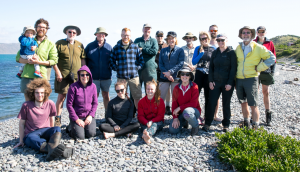FOMI Work Trip 17-19 August, 2018
It was all hands on deck Saturday morning to move 80 waratahs, pitfall pails and cups, around 20m of downpipe pipe, cow’s ear tags + the tools needed to install all of these in place. Wheelbarrows were used top and bottom the hill. The route was up the Central Track and north into the no access track to the site of the mature flax trial site. Amazingly everything was on site by 10am Saturday morning. A huge effort by all! The reason for our volunteers to carry this – the Rhino (quad vehicle) was out of action.
By the end of Saturday all 80 mature flax plants, selected as hosts, had an ear tagged waratah close by and 2 pitfall traps set to capture lizards and invertebrates. Colin Miskelly led the work at the site. William Brocklesby, (DOC staff and master’s student) worked through the day with a small team of volunteers to complete this work.
The majority of our group of 14 volunteers returned to the site Saturday night to do 2 minute observations of each tagged flax plant – invertebrate and lizard counts were carried out and recorded. Sunday morning the pitfall traps were checked, catches recorded and traps closed until our October work trip when we will repeat the monitoring, hopefully with a number of those trained this trip. At least one adult flax weevil had reached this area.
Dale, Richard Grasse, Bruce and Richard Gray shared 2-3 hours over the nights at the fluttering shearwater colony capturing returning birds from burrows. They recorded band and burrow numbers. The birds present are a good indicator of the success of the upcoming breeding season. 2 Mana bred chicks were amongst the small sample of birds handled.
Gillian and Peter completed monitoring all the ’covers’ inside and outside of the area which once contained the ngahere geckos. Pretty normal for winter, no ngahere were spotted. Gillian was busy also doing other tasks, including interviewing individuals for her DomPost article. She will use Dale and Allan’s photos to support her article.
David Cornick carried out tasks Jason had assigned including shifting the northern rata interpretation sign, capping display boards and shifting the demo WFSP burrow to an easily found spot at the southern/petrel shed track intersection.
Tania, Bruce, Allan Sheppard and Richard Gray monitored the growth/health of the young flax trial plants.
Richard Gray and newbie Amber Brooks completed a circuit of all 20 x 5 minute bird count points. No surprise that kakariki, bellbird and whitehead were most numerous at most points. Annemieke, Peter, Richard Grasse and Dale began clearing vegetation at the green gecko site. We are awaiting iwi permission to install a gecko fence ahead of a proposed green gecko transfer in October. Fence construction should take place on our early October work trip.
A really diverse range of tasks were covered – some not mentioned here. There is a change of focus on these trips from physical jobs to monitoring and training people in the skills required to do this work. Another excellent weekend effort from a dedicated group of volunteers.
Nick and Gen were off island. Dallas and Geoff assisted where they could with our work.
Dale Shirtliff, FOMI Executive Member
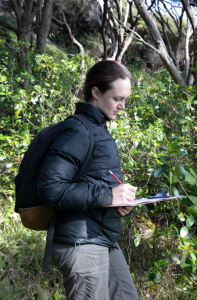
Amber doing a 5 minute bird count.

Richard removing muehlenbeckia roots – gecko fence site.
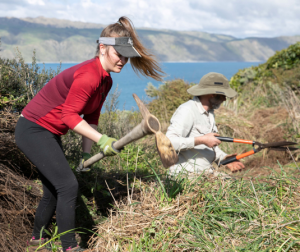
Annemieke and Peter clearing vegetation at the gecko fence site.
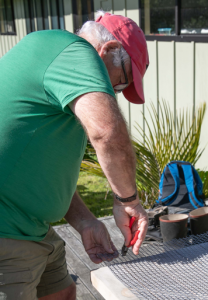
Alan Wright preparing mesh covers for the flax site pitfalls.
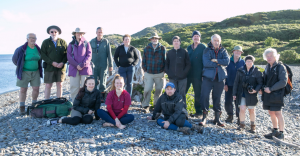
FOMI Work Trip 5–7 October, 2018
The weather was very kind. Sunscreen was essential and the breezes were gentle. Almost all of our 17 strong group were involved in monitoring geckos, invertebrates, birds or flax plants. Over our work trips this year a shift in focus to these activities has been noticeable. Learning monitoring protocols, observation and ID skills and sharing knowledge and ideas has been enthusiastically taken on by our volunteers, with some showing great leadership skills.
David Cornick, Allan and newbie Jaz erected the green gecko fence about 400 m up the southern Tirohanga Track. The variation in angles of slope made this a really challenging task with the particular fencing material used. A few finishing touches are required before the enclosure will be ready for green geckos to be transferred.
The flax weevil project begun in August involved a lot of our time and energy. Colin Miskelly was again on hand to lead us through setting up pitfall traps Saturday morning, doing 2 minute flax plant observations after dark on Saturday evening and Sunday morning monitoring finds and closing down the pitfalls.
Peter Tierney and Heather lead the ngahere monitoring group which included Jess, Chris, Annemieke and Jozef. The group had success in finding a ngahere. In transferring planter tubes to new fadges the team came across ‘many litres’ of Raukawa geckos. Their monitoring work completed on Saturday, they were available to assist in other areas Sunday.
Linda, Amber and Peter Simpson spent Sunday refreshing their 5 minute bird count skills, covering the 20 bird count stations. Kakariki, bellbirds and whiteheads are Mana’s most common and widespread birds. Peter Simpson, Cathye and Chris began retagging trees light-welled since 2015. Peter and Dale will visit Mana again soon to complete this work. Peter spent many hours on his computer pre-trip reassigning plant numbers and generally tidying up records.
Cathye, Philippa, Heather and Colin recorded the state of health of last year’s flax plantings. Track clearance work was carried out by Chris, Jess and Allan. Linda and Richard cleared the wetland track in preparation for more extensive work later in the year/early 2019. Sunday assistance was provided by Annemieke and Jozef.
A note from Colin – some good news – the first of the 2015 & 2016 translocated fairy prion chicks has been recovered alive and well back on Mana Island. One fledged from Mana Island on 25 January 2015 at a weight of 119 g, 4 days after translocation from Takapourewa. The bird was found in burrow on this trip, about 10 metres from the nearest fairy prion burrow. It was seen going into a burrow and and later an adjoining burrow between 2300 and 2330 by Cathye Simpson, Annemieke Hendriks and myself during a FOMI working weekend visit.
Colin, Nick and Dale discussed details of the irrigation system to be set up to supply 40 mature flax plants water over the dry parts of the summer – part of the Flax Weevil/Beauveria fungus trial.
Genial hosts Nick and Gen kept in contact throughout and took care of our materials transport needs. Young Theo shared a high 5 with me just as we were leaving. As usual the food was great, the friendly and sharing atmosphere wonderful.
Dale Shirtliff, FOMI Executive Member
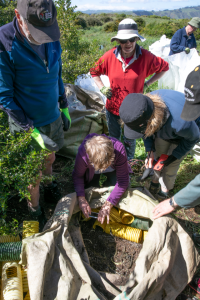
Removing planter tubes – full of geckos!
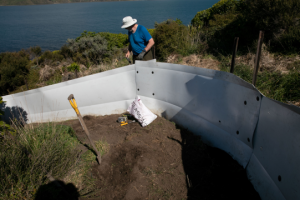
Allan working on the difficult fence joins with slope changes.

Identifying skinks found in pitfall traps.
